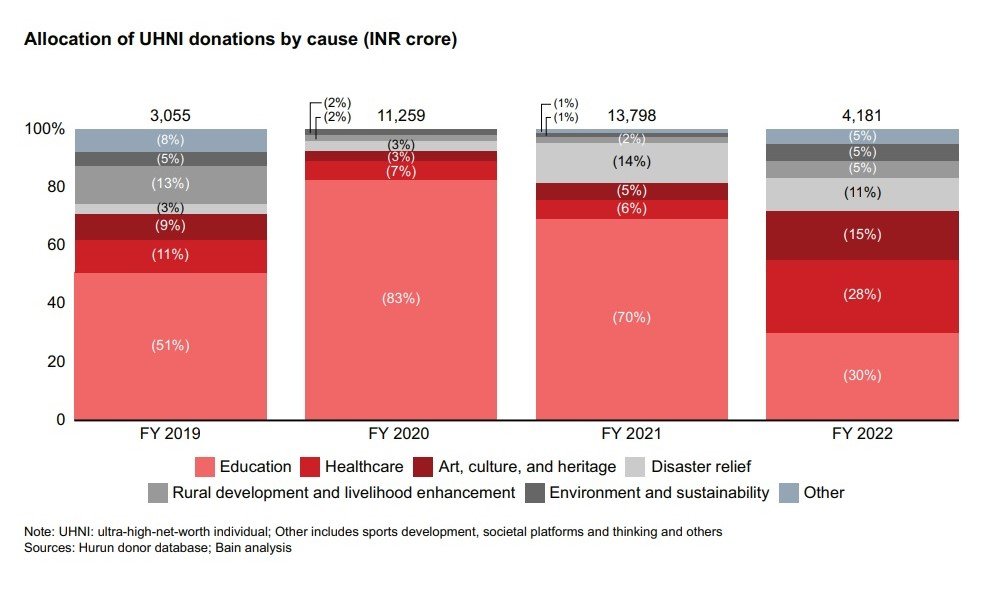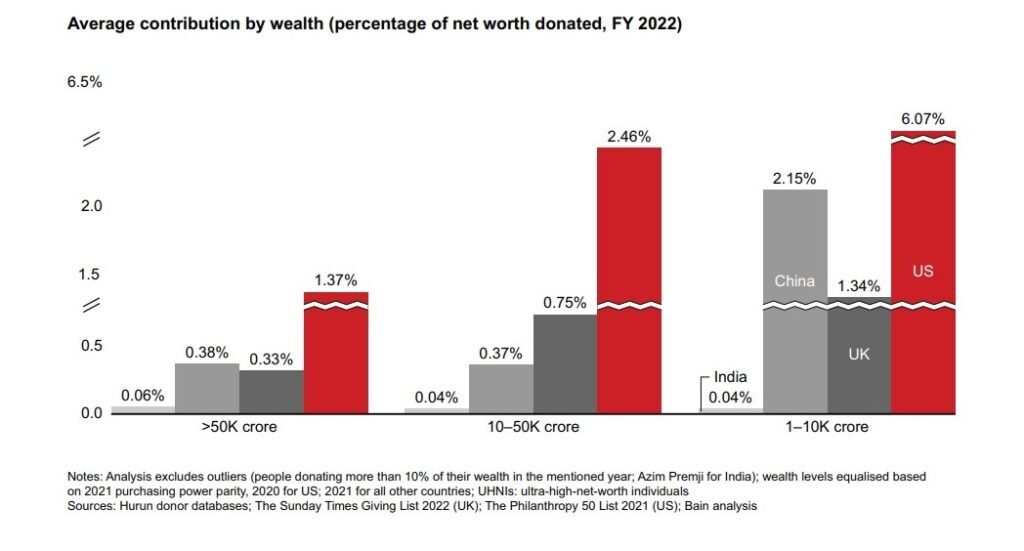The analysis underscores the potential for growth in philanthropy in India and the need for more significant engagement strategies to encourage giving.
Family philanthropy, which includes contributions from UHNIs (net wealth >INR 1,000 crore), HNIs (net wealth of INR 200–1,000 crore), and affluent givers (net wealth of INR 7–200 crore), is a significant source of private domestic contributions. Despite a funding deficit in the social sector, this form of giving can bridge the gap, currently accounting for 33% of private domestic contributions. It’s projected to grow annually by 12% through FY 2027.
UHNI Philanthropic Contributions: Wealth Creation Vs. Donation
While the wealth of Indian UHNIs is rising, their philanthropic contributions are falling short. A 5% contraction in UHNI giving in FY 2022 indicates a lag in philanthropy in relation to wealth accumulation. When compared with their counterparts in countries like the US, UK, and China, Indian UHNIs give significantly less across all wealth levels. Therefore, amid increasing UHNI wealth, it is crucial for more individuals to escalate their contributions.
Philanthropic Trends in India: Education and Healthcare Take the Lead
In India, philanthropic contributions have traditionally favored the education and healthcare sectors. Over FY 2020 and FY 2021, Azim Premji alone gave about INR 16,000 crore towards education. Even when excluding his contribution, these two sectors accounted for a significant share of UHNI giving. Interestingly, philanthropy in developed countries displays more variety, whereas, in India, a considerable majority of UHNIs prefer giving to education or healthcare.
Share of education and healthcare dropped in FY 2022

Also read: CSR: Bharat Forge Empowers The Future: Championing Skill Development Among Youth
Future Potential: HNIs and Affluent Population Giving
The growth in giving from the HNI and affluent populations can be attributed to a 12% increase in the affluent population and a 7% increase in the HNI population. Their combined contribution increased by 11% over FY 2021 to INR 25,300 crore. Moreover, these populations are expected to grow in the future, highlighting their potential in augmenting philanthropy in India.
The Rise of Retail Giving: Digital Enablement and Community Giving
Retail giving rose by 18% over FY 2021, reaching INR 32,700 crore in FY 2022, propelled by increased contributions to NGOs, disaster relief funds, and community giving. The advent of digital platforms for giving has been central to this growth, with payment apps featuring active in-app disaster relief funds and NGO donations. Furthermore, crowdfunding platforms raised substantial amounts during the pandemic, underscoring the potential of online giving channels in the future.
Giving as a percentage of wealth for Indian UHNIs is low across wealth levels when compared to the US, China, and UK

Also Read: Family Philanthropy To Grow By 18% In India: Report I India CSR
The Impact: Azim Premji’s Philanthropy
Azim Premji’s philanthropic contributions have made a significant impact in India’s social sector. His giving dropped by INR 9,000 crore in FY 2022, largely due to the share buy-back in 2021 which directly benefited the foundations. Even with this decrease, his significant contributions, especially towards education, have set a benchmark for other UHNIs to follow.
A Deep Dive into UHNI Net Wealth
UHNI’s net wealth in India saw an increase of 9.2% in FY 2022. In particular, wealth exceeding INR 50,000 crore witnessed a 19% jump. Despite this wealth increase, donations from top donors have grown at a moderate rate, showing a disconnect between wealth accumulation and philanthropy. Thus, there is a significant potential for UHNIs to step up their giving.
International Comparison of UHNI Donations
When compared to UHNIs in the US, UK, and China, Indian UHNIs lag considerably in their donations. If Indian UHNIs matched their international counterparts, their total contribution could potentially increase by 8–13 times. Therefore, it is important for Indian UHNIs to elevate their philanthropic contributions.
Table 1: UHNI Donations
| S.No | Fact |
|---|---|
| 1 | Despite an increase in UHNI wealth by 9.2% in FY 2022, philanthropic contributions have seen a 5% contraction. |
| 2 | Compared to their counterparts in the US, UK, and China, Indian UHNIs donate significantly less across all wealth levels. |
| 3 | Over FY 2020 and FY 2021, Azim Premji contributed about INR 16,000 crore towards education, demonstrating the sector’s appeal for UHNI philanthropy. |
| 4 | In India, 70%–75% of UHNIs contribute at least a portion of their giving towards education or healthcare sectors. |
Affluent Population and Their Role in Future Philanthropy
With the affluent population in India predicted to grow to 15.5 lakh individuals by FY 2027 from the current 8.7 lakh individuals, their role in philanthropy is set to increase. Their giving behavior, which is driven by emotional connections to certain causes, underscores the need to engage and enable their philanthropic journeys.
The share of formal giving rose from 11% in FY 2017 to 22% in FY 2022

The Growth of Retail Giving and Its Drivers
The growth of retail giving has been spurred by various factors, including an increase in community giving and digital enablement. In particular, community giving has experienced a growth of 20%, signifying its importance in times of need. Meanwhile, the increasing adoption of digital giving innovations, such as Unified Payments Interface (UPI), crowdfunding, and e-commerce–based giving, have further facilitated the growth of retail giving.
Table 2: HNIs and Affluent Giver’s Donations
| S.No | Fact |
|---|---|
| 1 | The combined philanthropic contribution of the HNI and affluent populations increased by 11% over FY 2021 to INR 25,300 crore, driven by a rise in their populations. |
| 2 | The affluent population is expected to play a significant role in future philanthropy with its population predicted to rise to 15.5 lakh individuals by FY 2027. |
| 3 | HNI and affluent giving behaviours can often be driven by narratives or stories that stir an emotional connection, compared to having a specific sectoral affinity. |
The Role of Technology in Enabling Philanthropy
Technological advancements have played a pivotal role in enabling philanthropy. From in-app features in payment apps that facilitate donations to NGOs and disaster relief funds, to crowdfunding platforms raising significant amounts during the pandemic, technology has revolutionized philanthropy. In fact, it is predicted that half of all giving in India will occur through online channels within the next five years, highlighting the impact of technology on the future of philanthropy.
Table 3: Retail Giving
| S.No | Fact |
|---|---|
| 1 | Retail giving rose by 18% over FY 2021 to INR 32,700 crore in FY 2022, propelled by increased contributions to NGOs, disaster relief funds, and community giving. |
| 2 | Of all retail giving, 78% goes towards community giving, with peer-to-peer healthcare donations being the biggest contributor. |
| 3 | Crowdfunding platforms such as Milaap, Ketto, ImpactGuru, and Give raised over INR 3,600 crore in 2020, driven by increased online giving during the pandemic. |
| 4 | It is predicted that 50% of all giving in India will occur through online channels within the next five years, due to the increasing adoption of digital giving platforms and innovations. |
The Emergence of Crowdfunding Platforms
Crowdfunding platforms have witnessed a surge in contributions over the years, particularly during the pandemic. Platforms such as Milaap, Ketto, ImpactGuru, and Give raised over INR 3,600 crore in 2020, indicating the potential of these platforms in formalizing retail giving. The accessibility and simplicity of these platforms make them an attractive avenue for individuals to contribute towards various causes.
A Shift in Philanthropic Behaviour
As India’s affluent and HNI populations grow, their philanthropic behaviours show signs of mirroring retail givers. This shift suggests that their giving choices are often driven by narratives or stories that create an emotional connection rather than specific affinity towards a sector or cause. Understanding this behaviour can be key in encouraging more significant and regular contributions from these demographics.
Also Read: How Digital Education Can Solve The 5 Biggest Educational Challenges That India Is Facing?
Encouraging the Affluent to Give More
Given the projected growth of the affluent population, it’s essential to engage this group and facilitate their philanthropic journeys. Platforms such as Give’s crowdfunding events have successfully engaged affluent givers, with 30% of funds raised from this demographic. Such initiatives highlight the untapped potential of affluent givers in India.
The Rise of Community Giving in Retail Philanthropy
Community giving has become a significant part of retail giving, accounting for 78% of total donations. The majority of these contributions go towards peer-to-peer healthcare donations. As the community continues to support each other in times of need, we can expect a further rise in community giving.
The Growing Influence of Digital Innovations in Philanthropy
Digital innovations such as Unified Payments Interface (UPI), crowdfunding, and e-commerce–based giving have played a central role in increasing formal giving. Furthermore, disaster relief funds and NGO donations have become popular in-app features on widely used payment apps. These trends suggest a promising future for digital giving in India, which is predicted to account for 50% of all giving within the next five years.
About the Author
Rusen Kumar, the Founder and Managing Editor of India CSR, is a highly accomplished and seasoned media person and social thought leader in India. He was recently honored as a Social Impact Leader by ASSOCHAM.
The article is based on India Philanthropy Report 2023.



Credit:Source link



